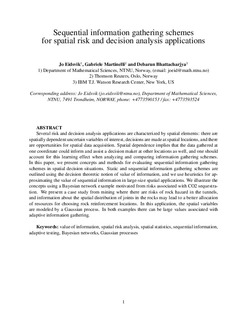| dc.contributor.author | Eidsvik, Jo | |
| dc.contributor.author | Martinelli, Gabriele | |
| dc.contributor.author | Bhattacharjya, Debarun | |
| dc.date.accessioned | 2018-09-05T07:12:15Z | |
| dc.date.available | 2018-09-05T07:12:15Z | |
| dc.date.created | 2018-09-04T11:45:10Z | |
| dc.date.issued | 2018 | |
| dc.identifier.citation | Stochastic environmental research and risk assessment (Print). 2018, 32 (4), 1163-1177. | nb_NO |
| dc.identifier.issn | 1436-3240 | |
| dc.identifier.uri | http://hdl.handle.net/11250/2560813 | |
| dc.description.abstract | Several risk and decision analysis applications are characterized by spatial elements: there are spatially dependent uncertain variables of interest, decisions are made at spatial locations, and there are opportunities for spatial data acquisition. Spatial dependence implies that the data gathered at one coordinate could inform and assist a decision maker at other locations as well, and one should account for this learning effect when analyzing and comparing information gathering schemes. In this paper, we present concepts and methods for evaluating sequential information gathering schemes in spatial decision situations. Static and sequential information gathering schemes are outlined using the decision theoretic notion of value of information, and we use heuristics for approximating the value of sequential information in large-size spatial applications. We illustrate the concepts using a Bayesian network example motivated from risks associated with CO2 sequestration. We present a case study from mining where there are risks of rock hazard in the tunnels, and information about the spatial distribution of joints in the rocks may lead to a better allocation of resources for choosing rock reinforcement locations. In this application, the spatial variables are modeled by a Gaussian process. In both examples there can be large values associated with adaptive information gathering. | nb_NO |
| dc.language.iso | eng | nb_NO |
| dc.publisher | Springer Verlag | nb_NO |
| dc.title | Sequential information gathering schemes for spatial risk and decision analysis applications | nb_NO |
| dc.type | Journal article | nb_NO |
| dc.description.version | submittedVersion | nb_NO |
| dc.source.pagenumber | 1163-1177 | nb_NO |
| dc.source.volume | 32 | nb_NO |
| dc.source.journal | Stochastic environmental research and risk assessment (Print) | nb_NO |
| dc.source.issue | 4 | nb_NO |
| dc.identifier.doi | https://doi.org/10.1007/s00477-017-1476-y | |
| dc.identifier.cristin | 1606546 | |
| dc.description.localcode | This is a pre-print of an article published in [Stochastic environmental research and risk assessment]. The final authenticated version is available online at: https://doi.org/10.1007/s00477-017-1476-y | nb_NO |
| cristin.unitcode | 194,63,15,0 | |
| cristin.unitname | Institutt for matematiske fag | |
| cristin.ispublished | true | |
| cristin.fulltext | preprint | |
| cristin.qualitycode | 1 | |
